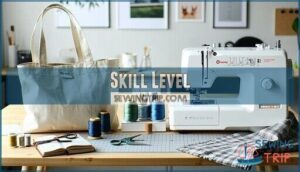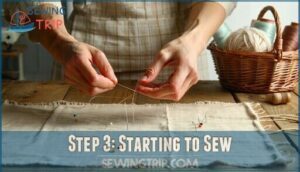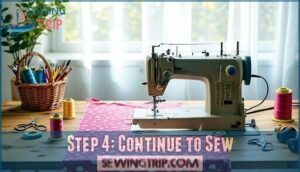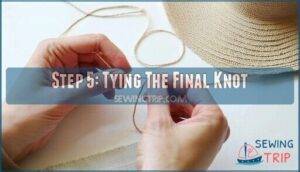This site is supported by our readers. We may earn a commission, at no cost to you, if you purchase through links.

Start by threading your needle (yes, it’s tricky, but you’ll nail it with time) and tying a secure knot at the end.
Push the needle through the fabric, keeping stitches evenly spaced and not tugging the thread too tightly.
Straight stitches are a great way to begin—aim for about 1/4 inch between each.
Use chalk or a pen to mark your stitch line and match thread color to your fabric for a neat finish. Soon, you’ll be stitching like a pro—one knot at a time!
Table Of Contents
Key Takeaways
- Start by threading your needle and tying a secure knot, then practice basic stitches like the running stitch to get comfortable.
- Keep stitches evenly spaced, around 1/4 inch apart, and don’t pull the thread too tight to avoid puckering.
- Begin sewing slightly away from the fabric’s edge to prevent fraying, using a chalk or pen to guide your stitch line.
- Finish your sewing with a snug knot, trim the thread close but not too close, and inspect your work for loose stitches.
Hand Sewing Basics
Hand sewing is a simple skill that starts with threading a needle and tying a knot.
Hand sewing unlocks creativity, transforming simple threads into beautiful, functional creations with just a needle and a little patience.
With a little practice, you’ll create neat, even stitches that hold your fabric securely.
Thread Needle and Tie Knot to Secure
Threading a needle and tying a knot might seem tricky, but it’s easier with a few tips.
- Pick the right needle: Use sharp sewing needles for delicate fabrics or blunt ones for heavier materials. Choose a needle with an eye big enough for your thread.
- Cut your thread: Measure about an arm’s length—too short, and you’ll run out; too long, and it may tangle.
- Thread the needle: Flatten the thread’s end or lick it slightly for easier needle threading.
- Create tension: Roll the thread between your fingers before pulling it through the needle’s eye.
- Tie a knot: Secure stitches by knotting the thread’s end snugly. Double-knot if needed for extra security.
Using the right sewing needle types is essential for successful sewing projects.
Master these basics, and you’re ready for confident sewing!
Push Needle Through Fabric, Not at Edge
When you’re ready to sew, start by positioning the needle slightly away from the fabric’s edge. This prevents fraying and keeps your stitches secure.
Hold the fabric taut but not stretched, maintaining even fabric tension. Angle the needle carefully to pierce straight through the fabric layers without snagging.
Focus on thread control, guiding it smoothly to avoid tangles. Adjust your stitch depth to match the project’s needs, whether it’s a delicate hem or sturdy seam.
Patience turns these sewing basics into polished results!
Keep Stitches Evenly Spaced
Even spacing is the secret to neat sewing stitches.
Aim for a stitch length of about 1/4 inch.
Keep your sewing rhythm steady and follow the fabric grain using these tips:
- Use a pencil or chalk to mark stitch lines.
- Insert the needle straight, not angled.
- Gently adjust thread tension.
- Check spacing as you go.
The key to successful sewing is maintaining a steady rhythm and following the fabric grain, which will help achieve even spacing.
Finish With Knots to Secure Thread
When you’ve sewn your last stitch, it’s time to secure everything with finishing knots. Start by gently pulling the sewing thread tight—no yanking! Tie a simple overhand knot close to the fabric, ensuring it hugs the surface snugly.
For extra knot strength, add a second knot right on top. Got shaky hands? No worries, practice makes perfect!
Trim the thread ends near the knot, but leave a tiny tail for good measure. This keeps your sewing stitches intact and prevents unraveling.
Whether it’s a slip stitch or straight stitch, secure stitches are your project’s safety net.
Match Thread Color to Fabric
Securing your thread is one thing, but matching it to your fabric? That’s the real game-changer.
Matching thread to fabric elevates your project, transforming stitches into an almost invisible, polished masterpiece.
Thread matching makes your stitches nearly invisible, giving your project a polished, professional vibe.
Hold sewing threads against your fabric in natural light to check color selection—dye lots can vary, and shades might surprise you.
Sticking to similar fabric shades, like navy thread on denim, keeps things seamless.
Want to shake it up? Go bold with contrast choices for a decorative touch.
Whether hand-sewing or using a sewing machine thread, thoughtful color choices elevate your sewing from basic to brilliant.
Use Chalk/pen to Mark Stitch Line
After matching your thread to the fabric, grab a marking tool like chalk or a fabric marker to sketch your stitch line.
This simple sewing aid keeps your stitches straight and your project looking polished.
Drawing a clear guide guarantees accuracy, especially for beginners mastering sewing basics and sewing techniques.
Think of it as a GPS for your needle—no more guessing where to sew next!
Chalk methods or marking pens are great for temporary sewing markings that won’t ruin your fabric.
With practice, you’ll ditch the guides and stitch like a pro.
For now, let those lines lead the way!
Pull Thread Tight but Not Too Tight
When sewing, keep thread tension balanced—tight enough to hold but not so tight it puckers.
Think of it like tuning a guitar string—steady, not strained.
- Test on scrap fabric to find the right tension for your stitch length.
- Adjust for fabric stretch; thicker fabrics need looser tension.
- Slow your sewing speed for better needle control and consistent results.
Stitching Techniques
Mastering basic stitching techniques is key to building your sewing skills. You’ll learn simple stitches like straight, zigzag, and whipstitch to create strong and neat seams.
Straight Stitch: Keep Stitches 1/4 Inch Apart
A straight stitch is your bread and butter in sewing, so let’s nail it down.
Keep your stitches 1/4 inch apart for neat, even lines.
Adjust your sewing machine’s stitch length and thread tension based on your fabric choice—longer for thick materials, shorter for delicate ones.
Don’t rush; steady sewing speed guarantees control.
Pair the right needle size with your project for smooth stitching.
These simple stitches are the foundation of countless sewing tutorials and projects.
Mastering a sewing machine is essential for any sewing enthusiast to produce professional-looking results, and it is the key to steady sewing speed and smooth stitching with the right needle size.
Basting Stitch: Hold Layers Together
After mastering the straight stitch, let’s talk about the basting stitch—your go-to for temporary fixes.
This sewing technique is perfect for layer alignment when piecing quilts, prepping seams, or testing fabric placement.
Use long, loose sewing stitches about 1/4 inch apart, keeping stitch length consistent for easy removal later.
Focus on fabric tension—keep it snug but not stretched.
Whether hand or machine sewing, choose contrasting thread for visibility and adjust your sewing speed for precision.
The basting stitch isn’t permanent, but it’s a reliable helper to keep your project steady before committing to final stitches.
For more information on sewing techniques, understanding the basting stitch process is essential for beginners.
Zigzag Stitch: Stitch Diagonally
A zigzag stitch adds flexibility to your projects, letting fabrics stretch without tearing.
It’s perfect for hemming or reinforcing edges.
Use these sewing tips:
- Adjust your sewing machine’s thread tension for smooth diagonal sewing.
- Space zigzags closer on dense fabrics for durability.
- Practice stitch patterns on scraps before tackling big projects.
Say goodbye to boring straight stitches!
Slip Stitch: Sew Inside Fold
If you’ve ever wondered how to create magic with folded seams, the slip stitch is your go-to. This invisible stitch is perfect for sewing folds, fabric binding, and edge finishing.
Start by folding the fabric where you need the seam, hiding the raw edges inside. Insert your sewing needle into the fold, not through the edge, and make tiny, even stitches about 1/8 inch long. Pull the thread snugly so the stitches vanish into the fabric fold.
Finish with a secure knot tucked inside the seam allowance. Follow these sewing tips, and soon, your hand sewing will look professional and polished.
| Step | Action | Key Tip | Result |
|---|---|---|---|
| 1 | Fold fabric to hide raw edges | Keep folds neat | Seam looks clean |
| 2 | Insert needle inside the fabric fold | Avoid piercing the edge | Invisible stitching |
| 3 | Make small, even stitches | Keep stitches 1/8 inch long | Seam stays hidden |
| 4 | Knot inside the folded seam allowance | Double-knot for security | Seam is secure |
Backstitch: Sews Tight Seam
Backstitching is your go-to for strong stitches that won’t budge. Unlike a straight stitch, this technique reinforces seams, making it perfect for garments or pockets.
Here’s how you can master it:
- Start at the edge: Push the needle through and pull tight.
- Go back: Insert the needle into the previous hole, working in reverse.
- Keep it tight: Maintain even tension for a secure seam.
- Repeat: Stitch forward, then back, locking threads in place.
- Finish with a knot: Secure knots guarantee your work stays intact.
With these sewing tips, your seams will last!
Whipstitch: Connects Fabric Edges
The whip stitch is perfect for binding fabric edges with a secure, decorative touch.
Just weave your needle through both layers of fabric and loop the thread around the edge. It’s quick, simple, and adds charm to your sewing projects.
Experiment with colorful threads or playful spacing for a unique look. Whether you’re hemming or closing seams, the whip stitch is a handy trick to keep in your sewing toolkit.
| Whipstitch Tips | Details |
|---|---|
| Use Matching Thread | Blends seamlessly with fabric. |
| Secure Tight Loops | Guarantees strong edge finishing. |
| Play with Spacing | Adds creativity to stitches. |
| Ideal for Hand Sewing | No sewing machine needed. |
| Great for Decorative Edges | Adds flair to fabric binding projects. |
Blanket Stitch: Decorates Edges
The blanket stitch is a go-to for edge decoration that’s both functional and stylish.
Start by bringing your needle up through the fabric, forming a loop, and stitching back down near the last stitch.
Keep loops even for clean fabric borders.
This decorative stitch pattern is perfect for sewing edges on blankets, mending, or adding flair.
Master this with basic sewing notions!
Fabric Tips
Choosing the right fabric can make sewing easier and more enjoyable. Start with beginner-friendly options like cotton, and don’t forget to prewash!
Prewash Fabric Before Sewing
Before sewing, prewashing is your secret weapon against fabric shrinkage and color bleeding.
It also softens the material and prepares it for stitching.
Follow these steps:
- Check fabric type—cotton often shrinks most.
- Test remnants to avoid surprises.
- Wash gently on a delicate cycle.
- Air dry for controlled shrinkage.
- Follow care tips from the fabric bolt.
Understanding fabric prewashing methods is essential for achieving the best results.
Your sewing fabrics will thank you!
Choose Appropriate Fabric for Beginners
For sewing beginners, stick to simple fabric types. Cotton and linen are forgiving choices, thanks to their stable weave and ease of use.
Avoid stretchy fabrics like jersey until you’re confident. Prewash fabrics first to prevent shrinking.
Understanding fabric construction basics is essential for selecting the right material for your project.
| Fabric Type | Why It’s Beginner-Friendly | Best For | Pro Tip |
|---|---|---|---|
| Cotton | Easy to handle, stable weave | Clothing, crafts | Use all-purpose thread |
| Linen | Durable, lightweight, and crisp | Shirts, pants | Press seams for a clean look |
| Flannel | Soft, less fraying | Pajamas, blankets | Pair with sharp scissors |
| Poplin | Sturdy, smooth surface | Bags, décor | Match thread color carefully |
Use Longer Thread Than Needed
When starting your hand sewing projects, always pick a thread at least twice as long as you think you’ll need. Longer thread saves you from stopping mid-project, hunting for the sewing kit, and re-threading—a pause no one enjoys. Plus, you’ll appreciate having enough room to secure sturdy knots.
Here’s why longer thread improves your sewing efficiency:
- Reduce Stops: Longer threads mean fewer interruptions to re-thread the needle.
- Complete More Stitches: Cover more ground before running out of thread.
- Stronger Finishing: Extra thread guarantees you can double back for firm knots.
- Flexibility in Stitch Length: Adjust your stitch spacing without worrying about waste.
Pro tip: Don’t choose an excessively long thread either—it tangles easily! Aim for balance to keep sewing an easy-flowing process.
Gently Poke Needle to Avoid Yanking Thread
When working with sewing needles, gentle handling is key.
Instead of yanking, poke the needle through your fabric at a steady 90-degree angle.
This prevents tearing and keeps your stitch length consistent.
Pair this with proper thread tension to avoid puckering.
Think of it like threading a needle through a maze—slow and steady wins!
| Tip | Why It Matters | Pro Tip |
|---|---|---|
| Poke, don’t yank | Avoids fabric damage | Keep stitches smooth and even |
| Maintain thread tension | Prevents puckering | Use light, consistent pressure |
| Prep fabric first | Promotes smooth sewing | Wash, iron, and cut evenly |
| Match thread color | Blends stitches seamlessly | Test on scrap fabric first |
| Check sewing posture | Reduces hand strain | Sit upright, relax your grip |
Mastering needle control leads to cleaner, more professional hand sewing.
Skill Level
Your sewing skill level shapes the kinds of projects you can tackle confidently. Start small with simple accessories, then gradually work your way to more advanced creations.
Beginners Can Make Simple Projects
If you’re learning to sew, start with simple sewing projects for beginners to build confidence.
Here’s how:
- Pick forgiving fabrics like cotton for easier handling.
- Focus on basic sewing patterns, such as pillows or tote bags.
- Use sharp Sewing Tools and large-eye needles.
- Practice Thread Management by keeping lengths manageable.
- Explore free project patterns online for ideas.
With patience, beginner sewing becomes easier—and fun!
Novices Can Make St■ Animals and Pillows
Making stuffed animals and pillows is a perfect way to level up your sewing skills. Start with simple patterns—rectangles for pillow covers or basic animal shapes. For stuffed toys, choose soft fabrics like fleece or felt and fill them with toy filling like polyester fiber.
Don’t sweat imperfections; every stitch gets you closer to mastery. Here’s a quick guide to help you get started with your sewing projects.
| Project | Required Tools | Suggested Fabrics |
|---|---|---|
| Pillow Covers | Needle, Thread, Scissors | Cotton, Linen |
| Stuffed Animals | Needle, Thread, Filling | Felt, Fleece |
| Baby Blanket | Needle, Thread, Ruler | Flannel, Cotton |
Enjoy sewing for beginners and transform fabric into fun creations, which can help you improve your skills and make fun creations.
Experts Can Make Higher Quality Versions
As your sewing expertise grows, you’ll enjoy tackling advanced projects with unmatched precision and creativity.
You can master patterns and elevate garment construction by pairing quality fabrics like silk or cashmere with expert techniques. Achieve sewing precision with strong threads and a reliable sewing machine.
Skills like efficient stitching and attention to detail let you craft masterpieces that stand out.
- Choose premium fabrics like silk or cashmere.
- Perfect advanced techniques for sewing quality projects.
- Use a high-quality sewing machine for precision crafting.
- Focus on intricate patterns for stunning, custom results.
Sewing Newsletter Content
Want to master sewing for beginners? Start by subscribing to our sewing newsletter! It’s packed with tips, tricks, and sewing patterns to get you stitching confidently.
From understanding sewing tools and thread types to choosing the right fabrics, we’ve got you covered. You’ll find free patterns for dresses, tops, and jumpsuits—all designed to make learning fun and frustration-free.
Keep your sewing machine in tip-top shape with easy maintenance tips, or explore beginner sewing hacks that’ll save time and effort. Whether you’re curious about fabric selection or trying your first project, these weekly emails are your ticket to creativity.
Sign up today, grab your sewing patterns, and turn those “what-ifs” into handmade masterpieces. Happy sewing—you’ve got this! For more advanced techniques, understanding sewing blog crafting can help take your skills to the next level.
Step 1: Unravel and Cut
Before you start stitching, it all begins with proper thread management and cutting tools. Measure out about 18 inches using a measuring tape—just enough to avoid frustrating tangles. Keep it smooth and manageable.
Hold the thread steady and use sharp sewing scissors or a rotary cutter on a cutting mat to guarantee a clean cut. A smooth edge will make threading easier and help prevent fraying later.
When pulling the thread from the spool, do it gently to avoid knots. Think of this like setting up a good foundation—it saves headaches down the line.
Understanding fabric cutting techniques is vital for a successful sewing project. With your thread cut and prepped, you’re ready to grab your needle and focus on threading methods. A little patience here goes a long way!
Step 2: Weave
Now that you’ve cut your thread, let’s focus on weaving stitches.
Pull about 4 inches of thread through your needle’s eye—long enough for control without tangling.
Picture a sewing machine’s rhythm as you weave the needle in and out of the fabric, maintaining about a 1/4-inch gap between stitches.
Think of it like threading beads on a string; steady hands create magic!
Keep your stitches straight and tension even—too tight might wrinkle the fabric, too loose could leave gaps.
With time, you’ll manage thread tension like a pro, creating smooth, consistent lines perfect for beginner sewing projects or basic sewing patterns.
Step 3: Starting to Sew
Alright, you’ve got your fabric prepped and ready—it’s time to make that first move! With your needle threaded and the stitch line drawn, hold the fabric firmly. Push the needle through the marked spot, starting about an eighth of an inch from the edge.
Keep your grip steady but not too tight—thread control is key. Pull the needle back through, keeping the stitches straight and evenly spaced. Don’t yank the thread like you’re reeling in a fish; gentle tension is all you need.
Beginners often find the simple running stitch or whipstitch a perfect start—both keep things steady without stress. Stop occasionally to check your work. Are the stitches neat? Adjust as necessary.
Remember, learning to sew is about patience and practice. You’re stitching more than fabric—you’re building a skill! Mastering basic sewing steps is essential for creating professional-looking seams and hems.
Step 4: Continue to Sew
Continuing with the sewing process is where rhythm meets confidence. Focus on keeping your stitch length small and even—around 1/4 inch apart. Smooth hand positioning and steady sewing speed will help avoid mistakes.
Whether you’re stitching by hand or using a sewing machine, let the needle glide through the fabric effortlessly. Planning the sewing steps beforehand, such as choosing stitch types or adjusting sewing machine settings, makes a big difference.
Don’t yank the thread—tight but gentle thread management is key. Experiment with stitches like zigzags or blanket stitches after mastering the basics.
Sewing tips: take your time, embrace the journey, and enjoy watching your skills and creativity grow stitch by stitch!
Step 5: Tying The Final Knot
Tying the final knot is like putting a period at the end of a sentence—it secures your sewing process beautifully.
First, verify enough thread tail, about 2-3 inches, for knotting.
To anchor your work, make a backstitch or a few tiny stitches in place.
Then, form a loop near the fabric, and guide the needle through it.
Pull tight to create a secure loop.
For added knot security, repeat this step.
If you’re using slippery thread, a second knot is a lifesaver.
Keep thread tension even to avoid puckering your fabric.
Always guide the knot placement with your fingers for precision.
Sewing knots, like slip stitch and secure loops, are essential for neat finishes.
You’ve mastered another important step!
Step 6: Final Cut
The big finish is here! Once you’ve secured the final knot, it’s time to trim. Grab your sewing scissors—sharp ones make the difference—and snip the thread close to the knot, but not too close.
That little tail keeps things secure. Before you celebrate, inspect your work. Give the fabric a gentle tug to check the stitches.
If anything feels loose or uneven, tighten the knot or add another one. This step saves you from sewing errors like puckered fabric or unraveling threads.
With the thread neatly trimmed and tension balanced, admire your creation. It’s moments like this that make learning to sew rewarding. Now, onto your next sewing pattern masterpiece! You will achieve a big finish.
Frequently Asked Questions (FAQs)
How do I learn to sew?
Start sewing by threading a needle, practicing basic stitches like the running stitch, and using simple tools—scissors, fabric, and thread.
Follow beginner tutorials, be patient, and keep experimenting.
Mistakes? They’re just part of learning!
How do I become a sewing pro?
Becoming a sewing pro is like stitching confidence—start small, master basics like running stitches and backstitches.
Practice often, explore creative projects, and invest in quality tools.
Patience and passion will transform your skills into art!
How to start sewing?
Grab a needle, some thread, and fabric scraps.
Thread the needle (patience helps!), tie a knot, and practice a straight stitch.
It’s like doodling—trial, error, and fun lead to better stitches!
How do you practice sewing?
Did you know 60% of beginners struggle with stitch consistency?
Practice by sewing straight lines on scrap fabric.
Use a pencil to draw guides, go slowly, and don’t stress—mistakes are your best teacher!
How do you start a sewing project?
Pick a simple pattern and gather your materials—fabric, needle, thread, and scissors.
Double-check instructions, mark your seams, and take it slow.
It’s just fabric, after all—not brain surgery, so have fun experimenting!
How do you start a hand sewing journey?
Don’t overthink it—just thread a needle.
Start with a basic running stitch on scrap fabric.
Practice makes perfect, so embrace imperfect stitches.
Use sharp scissors, take it slow, and enjoy the process.
How do you start a simple sew?
Start by threading your needle, tying a knot, and marking your fabric.
Push the needle through the fabric’s backside, and stitch in a straight line.
Keep tension loose, stitches even, and finish with a knot.
What is the easiest thing to sew as a beginner?
A drawstring bag is the easiest.
It’s simple, quick, and doesn’t need fancy skills.
You’ll practice straight stitches while creating something useful—perfect for beginners.
Plus, you can customize it with fun fabrics, which makes it a useful project.
Can I teach myself sewing?
Learning to sew is like untangling a knot—patience and practice make it smooth.
Yes, you can teach yourself!
Start simple, like sewing a button, then gradually master stitches.
Mistakes? They’re your best teachers.
What is the easiest sewing stitch?
The running stitch is the easiest.
You just weave the needle in and out of the fabric, creating a dashed line.
Keep the stitches evenly spaced, and you’ve got an essential skill mastered—simple and effective!
Conclusion
Mastering how to simply sew might seem intimidating, but it’s surprisingly achievable with a little patience.
Whether you’re tackling straight stitches or experimenting with zigzags, each technique builds your confidence.
Don’t stress about perfection; even wobbly stitches have character.
Grab your tools, start small, and enjoy the process of creation.
Remember, every sewing pro began just like you—threading that first needle.
So, take a deep breath, plunge into it, and soon you’ll be stitching with ease!
- https://www.instructables.com/How-to-Sew./
- https://www.sewcanshe.com/blog/how-to-sew-easy-baskets-with-10-squares-layer-cake-leftover-project
- https://www.sewmuchado.com/tutorial-felt-flash-cards-memory-game/
- https://happiestcamper.com/how-to-make-a-reversible-table-runner-for-beginners/
- https://promo.seamwork.com/sewing-supplies-freebie/














